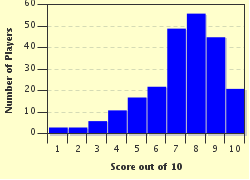Quiz Answer Key and Fun Facts
1. The first stage of Britain's colonization of Hong Kong was an outcome of this conflict, that had a severe effect on China's capacity to govern itself independently.
2. The War of the Roses was a violent conflict that was spawned by the families of two horticulturalists who both claimed credit for creating the 'Queen Elizabeth' rose.
3. Considered a war of genocide that could have been prevented, 800,000 are estimated to have been murdered in this central African nation before the killing stopped.
4. This surprise Autumn 1973 attack on Israel was originally successful for the Arab armies involved, who were supplied by their Soviet ally, but Israel rallied with significant logistical support from the US.
5. Sometimes known as the 'War to End All Wars', and the Great War, this 20th century conflict killed an estimated 15 million people and resulted in s significant realignment of the world map and power centres.
6. This conflict, which raged in the late 19th and early 20th centuries, pitted troops of the British empire against Dutch settlers who were farming in South Africa, and fighting for independence.
7. The Turbot War of 1995. What two countries were the two primary players?
8. What Scottish actor played the lead role in "300", a 2007 film about the war between the Spartans and the Persians?
9. What war was being fought when the White House was set ablaze?
10. The Battle of Ontario is fought several times a year between October and May at Scotiabank Place in the Nation's capital, and Air Canada Centre in Toronto. Weapons of choice are long slender sticks made of wood, graphite or titanium, with curved blades. Warriors travel on blades of steel on frozen surfaces. Battles are timed; 60 minutes for regulation time; maximum two (2) 5 minute overtime periods. Name the two opposing forces.
Source: Author
rwpm
This quiz was reviewed by FunTrivia editor
bloomsby before going online.
Any errors found in FunTrivia content are routinely corrected through our feedback system.

